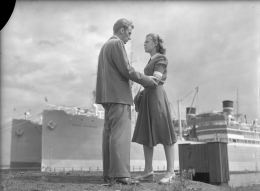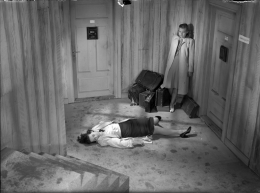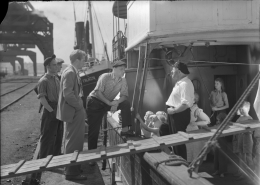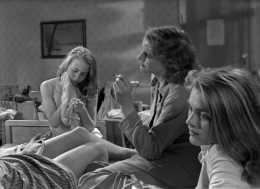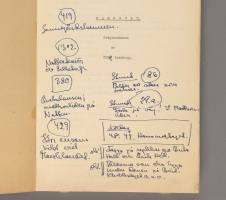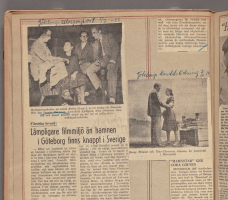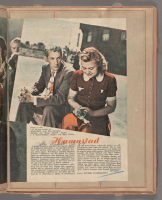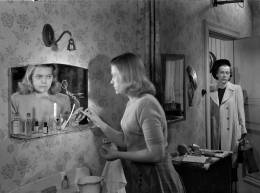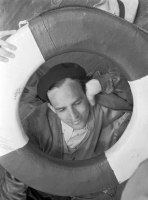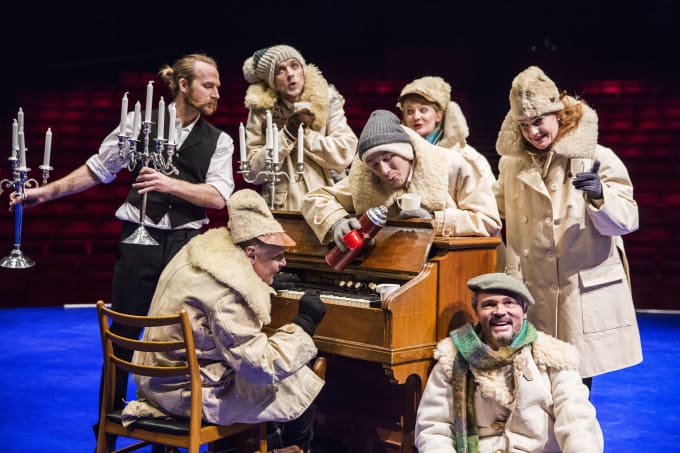Port of Call
In this drama about young love against the odds, a desperate reform school girl with a cruel mother meets a sailor who has just come ashore.
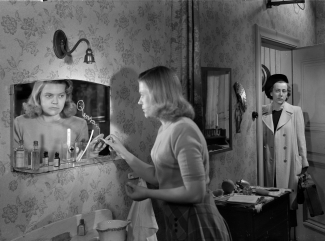
"Port of Call is Ingmar Bergman's best film to date - and one of the best films ever made in this country."Nils Beyer in Morgontidningen
About the film
In February 1948, Olle Länsberg (b.1922), sold what Ingmar Bergman said was a 'manuscript an inch thick' with the title 'The Gold and the Walls' to SF. Bergman was asked to work on a screenplay together with Länsberg and to direct the subsequent film. According to Bergman, the best thing about the initial project was 'going about Gothenburg with Länsberg and looking at the place from the inside. It was true I'd been living there for years, but I detested the place.'
Sources of inspiration
Probably the most influential cinematic style of the period immediately following the Second World War was Italian neo-realism. Asked in Bergman on Bergman whether he had allowed this to influence him, he replied: "Influenced it? It's in the spirit of Rossellini throughougt." At the time, he claimed, he had nothing of his own to offer:
'Each time I went to the cinema I thought 'this is what I must do, this is how it's got to be'. I felt every camera angle was a reproach to my own. I was staggering about, quite lost, and clutching at anything I could do. It wasn't my fault. Things had just turned out that way, without me knowing how or why, and I couldn't do a thing about it. I had no independence at all. I was helpless. A technical half-wit.'
In the same interview it was suggested to Bergman that the characters in Port of Call have more awareness and are less romantically conceived than in his earlier films. Bergman responded: "I've Länsberg to thank for that. The only bit of Harbour City which I wrote – and which is bad anyway and clashes with the rest of the film – is the hero's experiences when he gets drunk with a whore. It's a really miserable piece of work, thoroughly stylized and semi-literally, utterly out of tune with the rest of the film."
Sources
- The Ingmar Bergman Archives.
- Stig Björkman, Torsten Manns and Jonas Sima, Bergman on Bergman (New York: Da Capo P., 1993).
Alfa in Aftonbladet:
[...] 'A film of youth, for young people and about young people,' says the advertisement. Accordingly, it features sophisticated reformatory girls and illegal abortions, reaching its dramatic zenith with the aid of a bottle of Schenley whiskey. The action contains, as these ingredients might suggest, an erotic charge, yet the gunpowder is damp and the explosive effects no more dramatic than spitting on a hot water pipe.
The plot first conceived by Olle Länsberg is, in other words hopelessly dull, and Ingmar Bergman's lines often thud like blocks of wood on the visual narrative. His disjointed direction does little to alleviate these thuds. Nine-Christine Jönsson and Bengt Eklund give a convincing account of blonde and sulky Swedish love at its youngest they are not amusing, but they suit this film. Best of the bunch is the cinematographer G. Fischer in his documentary port exteriors.
Mikael Katz in Expressen:
On the question of Ingmar Bergman's contribution to Port of Call, opinions will no doubt be divided. Champions of cinematic magic, of 'demonic obsession' and of sophisticated sensational effects are bound to be disappointed. But those, or should I say those of us, who think that the form of a film should be dictated by its content, who consider the core more important than the exterior, are bound to think that Port of Call is Ingmar Bergman's most mature work to date. A work of a sophisticated and skilful director, who has been spellbound by his subject and has humbly submitted to it without resorting to virtuoso wizardry. As ever in Ingmar Bergman's films there are outstanding acting performances. Fortunately there is still something demonic in the way he coaches his actors he has a fantastic ability to make them glow.
Robin Hood in Stockholms-Tidningen:
Every scene in itself is well constructed enough, but the film as a whole fails to deliver. One is left unmoved. This may be down to the subject: one is weary of abortions, 'women's prisons', social workers, of cheap seductions and equally cheap dance joints they are tedious. Yet most of all this feeling of tedium is down to the director, Ingmar Bergman. He does show skill even here, but no verve.
"Port of Call is Ingmar Bergman's best film to date and one of the best films ever made in this country."
Nils Beyer in Morgontidningen
Distribution titles
Aiyoku no minato (Japan)
Città portuale (Italy)
Hafenstadt (West Germany)
Havnebyen (Norway)
Havnebyens fristelser (Piger uden moral) (Denmark)
Una mujer libre (Spain)
Port of Call (Great Britain)
Port of Call (USA)
Satamakaupunki (Finland)
Ville portuaire (Belgium)
Ville portuaire (France)
Working title: Guldet och murarna
Production details
Production country: Sweden
Swedish distributor (35 mm): Svensk Filmindustri, Svenska Filminstitutet
Laboratory: FilmTeknik AB
Production company: Svensk Filmindustri
Make up: Firma Carl M. Lundh AB
Original work: Guldet och murarna Olle Länsberg
Aspect ratio: 1,37:1
Colour system: Balck and white
Sound system: AGA-Baltic
Original length (minutes): 99
Censorship: 074.222
Date: 1948-10-04
Age limit: 15 years and over
Length: 2735 metres
Release date: 1948-10-11, Cosmorama, Göteborg Sweden
Kaparen, Göteborg, Sverige
Röda Kvarn, Uddevalla, Sweden
Filming locations
Sweden (1948-05-27-1948-07-17)
Filmstaden, Råsunda (studio)
Göteborg
Hindås
On the train between Stockholm and Södertälje
Music
Title: La paloma, Alternative title: La paloma/Den dag, då mitt hem jag bytte mot friska sjön...
Composer: Sebastián Yradier (1859)
Lyrics: Sebastián Yradier (Spanish lyrics 1859)
Ernst Wallmark (Swedish lyrics)
Singer: Bengt Eklund
Title: Swing Time at Wauxhall
Composer: Sven Sjöholm
Comment: Instrumental.
Title: Det ligger en båt i hamnen
Composer: Sven Sjöholm
Comment: Instrumental.
Title: Cantique de Noël, Alternative title: Adams julsång/O, helga natt
Composer: Adolphe Adam (1850)
Lyrics: Placide Cappeau de Roquemaure (1847)
Augustinus Koch (Swedish lyrics 1889)
Singer: Sven-Olof Sandberg
Mark Sandberg, 1996:
The young and restless Bergman tries yet another filmic tradition here with this human story in the neorealist mode: 'I still had nothing of my own to offer. I just grabbed helplessly at any form that might save me.' The result is a naturalistic city film, in which one finds the closest thing to overt social critique in Bergman's entire oeuvre. Here the issues facing the young working-class girl Berit are a grotesquely hypocritical mother, a troubled past, difficulties building a future with her present lover, and a friend who dies after a back-alley abortion. Especially noteworthy in comparison with the other early Bergman films is the fact that the main characters choose a narrative resolution in real life instead of in some extra-social, extra-narrative space. The cinematographer who helped capture the grittiness of the waterfront milieu here is newcomer Gunnar Fischer, who became Bergman's main photographer throughout the 1950s.
Collaborators
- Nine-Christine Jönsson
- Bengt Eklund
- Mimi Nelson
- Berta Hall
- Birgitta Valberg
- Sif Ruud
- Else-Merete Heiberg
- Brita Billsten
- Harry Ahlin
- Nils Hallberg
- Sven-Eric Gamble
- Yngve Nordwall
- Nils Dahlgren
- Hans Strååt
- Erik Hell
- Torsten Lilliecrona
- Hans Sundberg
- Bengt Blomgren
- Hanny Schedin
- Helge Karlsson
- Stig Olin
- Erna Groth
- Bill Houston
- Herman Greid
- Kate Elffors
- Estrid Hesse
- Brita Nordin
- Vanja Rodefeldt
- Sture Ericson
- John W. Björling
- Rune Andreasson
- Inga-Lill Åhström
- Stig Ossian Ericson
- Siv Thulin
- Kolbjörn Knudsen
- Gunnar Nielsen
- Georg Skarstedt
- Carl Deurell
- Edvard Danielsson
- Nils Poppe
- Åke Engfeldt
- Nils Svenwall, Art Director
- Bengt Järnmark, First Assistant Cameraman
- Aaby Wedin, Boom Operator
- Olle Länsberg, Screenplay not used
- Gunnar Fischer, Director of Photography
- Lars-Eric Kjellgren, Unit Manager
- Gösta Ström, Unit Manager
- Oscar Rosander, Film Editor
- Sven Hansen, Production Mixer
- Erland von Koch, Music Composer
- Harald Molander, Production Manager / Production Coordinator
- Ingegerd Ericsson, Script Supervisor
- Louis Huch, Still Photographer
- Ingmar Bergman, Screenplay
